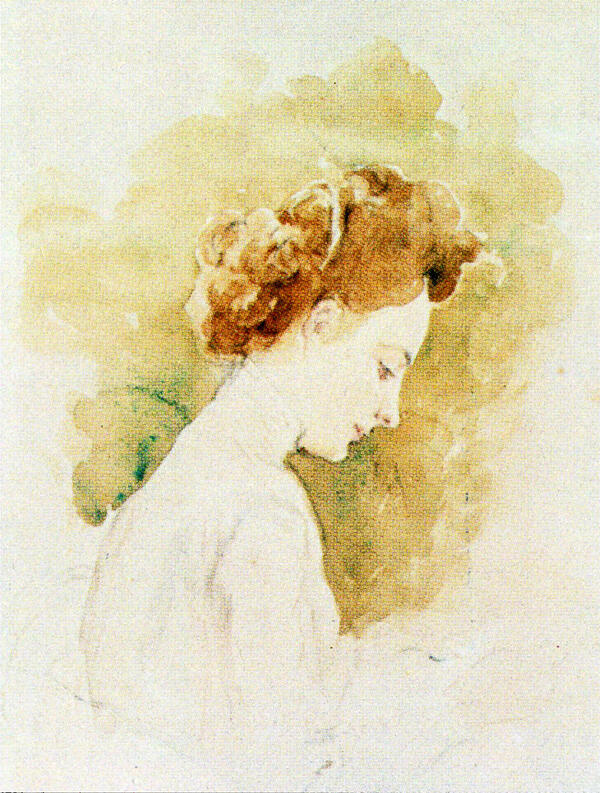The author of the portrait is Alexander Fomin. He was a landscape painter and professor at the Kiev Art Institute. At the end of the 1890s Fomin studied at the Kazan Art School together with Ksenia of Boratynskaya, granddaughter of the poet Yevgeny of Boratynskiy.
In her memoirs, she described the young Fomin as follows: ‘And here is Childe Harold standing alone during recess, leaning into a corner, arms crossed and looking from under his eyebrows. There’s a black storm of hair on his head, and the young man’s face is framed with a black beard. This one is showing promise-eyed, but he is too versatile. He’s a fine violinist. This is Fomin, and for his close comrades, Fomka, Fomushka… his inaccessible appearance is hiding a delicate, gentle soul. And the tone of his voice and the accent with some defect to the sound of ‘L’ made him not scary and very kind. Ten years after that, I used to meet him at our home, where he painted a portrait of mother and played on a violin in the evenings to the accompaniment of Lita’.
In Petersburg, Fomin attended Ilya Repin’s workshop, where his friend Nikolai Feshin studied at the time, and upon his return to Kazan participated in local exhibitions and taught painting. Alec Boratynskiy, the poet’s great-grandson, was one of his students.
The portrait depicts Olga Ilyin-Boratynskaya, a poet of the Silver Age of Russian poetry, and a Russian émigré. In February 1917, she married an officer of the Pavlograd Hussars regiment, Cyrill Ilyin. In September 1918, they marched eastwards with the White Army, leaving Kazan, and then emigrated to Harbin, and from there, to San Francisco. In 1951, in the United States, her autobiographical novel “The Dawn of the Eighth Day” about life in Kazan was published in English. One of the characters in the novel is Fomin.
In her memoirs, she described the young Fomin as follows: ‘And here is Childe Harold standing alone during recess, leaning into a corner, arms crossed and looking from under his eyebrows. There’s a black storm of hair on his head, and the young man’s face is framed with a black beard. This one is showing promise-eyed, but he is too versatile. He’s a fine violinist. This is Fomin, and for his close comrades, Fomka, Fomushka… his inaccessible appearance is hiding a delicate, gentle soul. And the tone of his voice and the accent with some defect to the sound of ‘L’ made him not scary and very kind. Ten years after that, I used to meet him at our home, where he painted a portrait of mother and played on a violin in the evenings to the accompaniment of Lita’.
In Petersburg, Fomin attended Ilya Repin’s workshop, where his friend Nikolai Feshin studied at the time, and upon his return to Kazan participated in local exhibitions and taught painting. Alec Boratynskiy, the poet’s great-grandson, was one of his students.
The portrait depicts Olga Ilyin-Boratynskaya, a poet of the Silver Age of Russian poetry, and a Russian émigré. In February 1917, she married an officer of the Pavlograd Hussars regiment, Cyrill Ilyin. In September 1918, they marched eastwards with the White Army, leaving Kazan, and then emigrated to Harbin, and from there, to San Francisco. In 1951, in the United States, her autobiographical novel “The Dawn of the Eighth Day” about life in Kazan was published in English. One of the characters in the novel is Fomin.
Fomin, together with Feshin, was in the circle of acquaintances of the Boratynskiy family. Olga Ilyina-Boratynskaya recalled: “They appeared when the domestic noise in our house calmed down, and brought their own noise of arguments and music, conversations about the books they read, about Russia and its future, about Nietzscheanism, about Tolstoyism, about religion… Prince Khromin with his sarcastic humor and elegance seemed to have nothing in common with artist Fomin, teacher of drawing of Alec”s, whose hair was sticking out feathers and who walked with an unhinged, self-conscious gait”.



